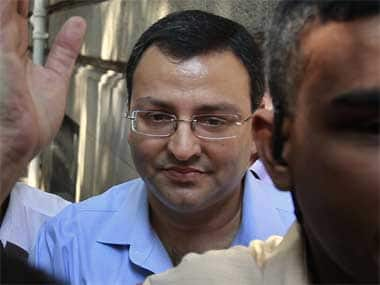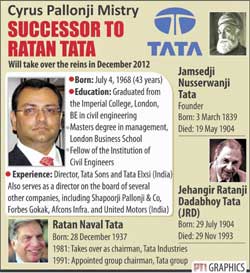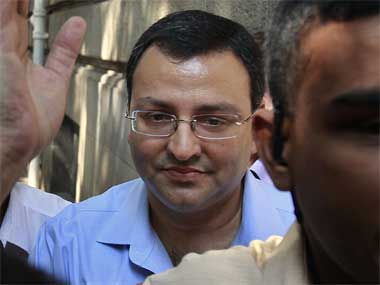One year to understand more than 100 companies operating across seven business sectors in more than 80 countries.
That’s the immediate challenge on hand for 43-year-old Cyrus Mistry, the man who was named successor to Ratan Tata as chairman of the Tata group, India’s largest business conglomerate.
It will be an incredibly demanding task, but Ratan Tata has full faith in his man. Describing the appointment, Tata said his decision was a “good and far-sighted choice” and that he had been “impressed with the quality and calibre of his (Mistry’s) participation, his astute observations and his humility.”
Several company observers agreed. Forbes India editor Indrajit Gupta called Ratan Tata’s decision “ a generational change ”. “This is a huge generational change. I think taking over the chairmanship of Tata’s at this age is great responsibility. Ratan Tata when he took over was also young but it was far less complex then,” he told CNN-IBN.
You can say that again. Today, the $83 billion Tata group straddles operations across business ranging from salt to software and employs a massive 425,000 people.Close to 60 percent of the group’s revenues comes from overseas. The group is also the largest industrial employer in the UK, accounting for nearly 50,000 UK jobs directly, with countless indirectly.
It’s a phenomenal transformation for a group that started as a textile business in 1868 by Ratan’s great-grandfather, Jamsetji Tata.Under Ratan Tata, the group transformed from a $5 billion group into a global giant, largely through acquisitions both at home and abroad.
Impact Shorts
More Shorts[caption id=“attachment_139457” align=“alignleft” width=“380” caption=“Mistry will have to work at consolidating the various businesses at a time of huge uncertainty in the global economy. It’s no secret that several of the top listed companies under the group are struggling financially. Rafiq Maqbool/AP”]
 [/caption]
[/caption]
The first overseas acquisition was made in 2000 when Ratan Tata paid $407 million for the UK-based Tetley group - the biggest by an Indian company at the time. According to a Bloomberg report , that was followed by another 65 mergers in India and abroad, totalling more than $20 billion, the most by any Indian group.
The group now owns the Jaguar and Land Rover brands, as well as European steel-maker Corus and Tetley Tea.
For Mistry, the task is two-fold.
One, he will have to work at consolidating the various businesses at a time of huge uncertainty in the global economy. It’s no secret that several of the top listed companies under the group are struggling financially.
Tata Steel, for instance, reported a 90 percent drop in profit for the quarter ending September over cooling demand and declining steel prices. The problem is exacerbated by the fact that a bulk of its revenues come from European operations (it acquired Corus, Europe’s second-largest steel-maker for $13 billion in 2007).
Then there is Tata Motors, whose biggest disappointment is the Nano, once touted as the world’s cheapest small car. In telecoms, Tata Teleservices and Tata Communications are struggling to cope with reducing profitability in an industry plagued by regulatory problems and the aftermath of the 2G scam. Another group company TCS, India’s largest IT services company, is also feeling the heat of the growing economic turmoil in Europe.
In addition, there is the fallout from the Niira Radia scam. While there are no financial implications, the image of the Tata group received a battering. No doubt, Mistry has a lot of fixing to do.It helps that Mistry, a civil engineer by training, has strong expertise in the formation of business plans, risk evaluation, business investment strategy and property and infrastructure development.
[caption id=“attachment_139465” align=“alignright” width=“250” caption=“Graphic courtesy PTI”]
 [/caption]
[/caption]
Two, because he is an unknown entity, he will have to work hard at earning the respect of fellow Tata officials. “I think he’ll have to earn respect. I don’t think any of the Tata managers will accept someone who they don’t respect,” said Forbes’ Gupta to CNN-IBN.
While Ratan Tata is already convinced, he’ll have to prove to other company officials and outsiders that Mistry has what it takes to make the leap from running a construction business to a variety of businesses.
More importantly, Mistry will need to erase the lurking suspicion that he got the top job simply because his father is the biggest shareholder of the Tata group.
Of course, Mistry is not a complete stranger to handling business empires: he has been heading his family’s Shapoorji Pallonji group since 2003, where he oversaw revenues of more than $2 billion.A 147-year old firm, Shapoorji boasts the tallest residential building in Indian and the largest cement clinker plant in India.
According to a Reuters report , Pallonji is dubbed the “Phantom of Bombay House” for the quiet but assured way he commands power around the south Mumbai headquarters of the Tata empire. That should somewhat reassure investors who still have to see what exactly his management style will be.
“It’s such a complex organisation, it’s a challenging position to step into. It’s very important that the new person has a vision for taking the group forward for the next 20-30 years,” Taina Erajuuri, a fund manager at FIM Asset Management in Helsinki, which owns stock in Tata firms, told Reuters.
Good luck, Mr Mistry.
)